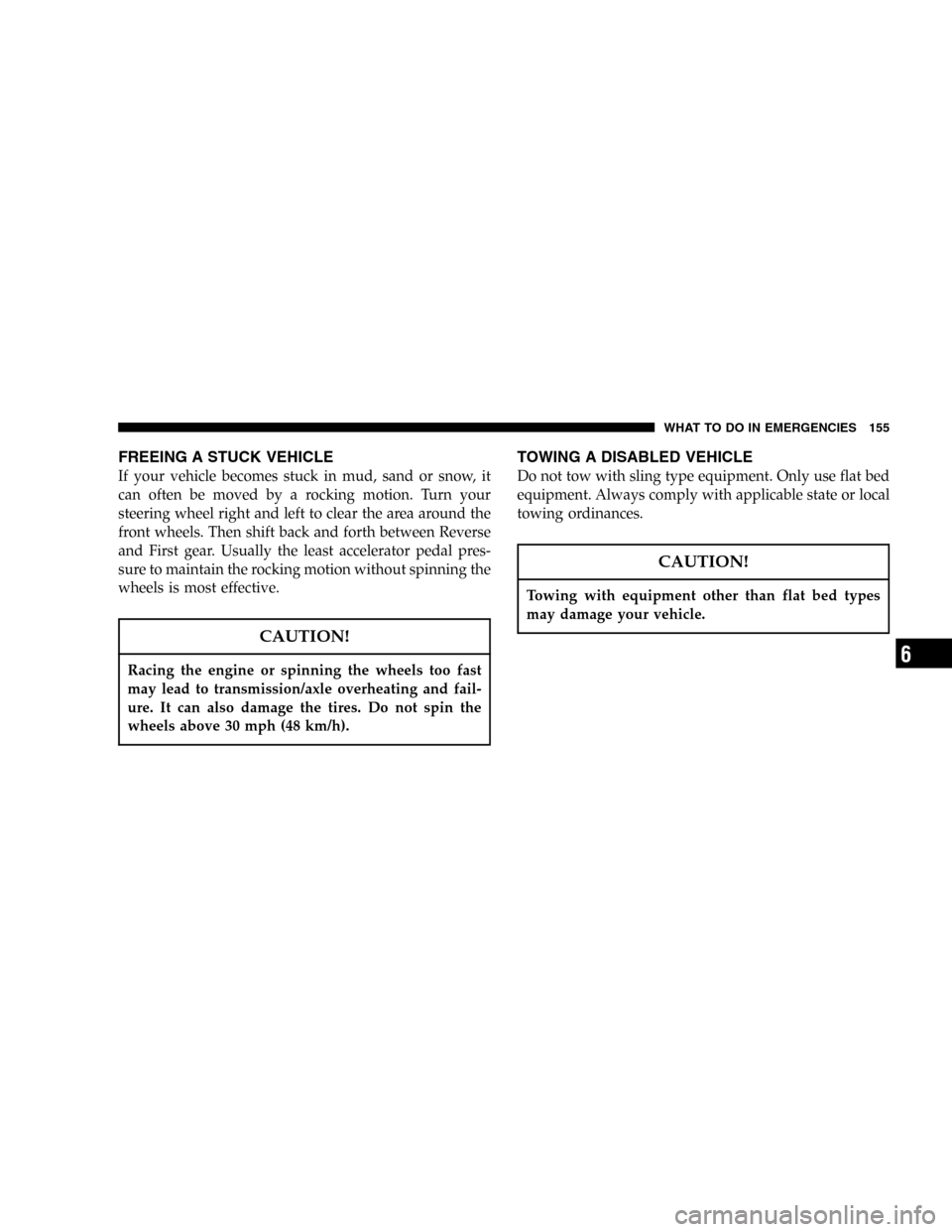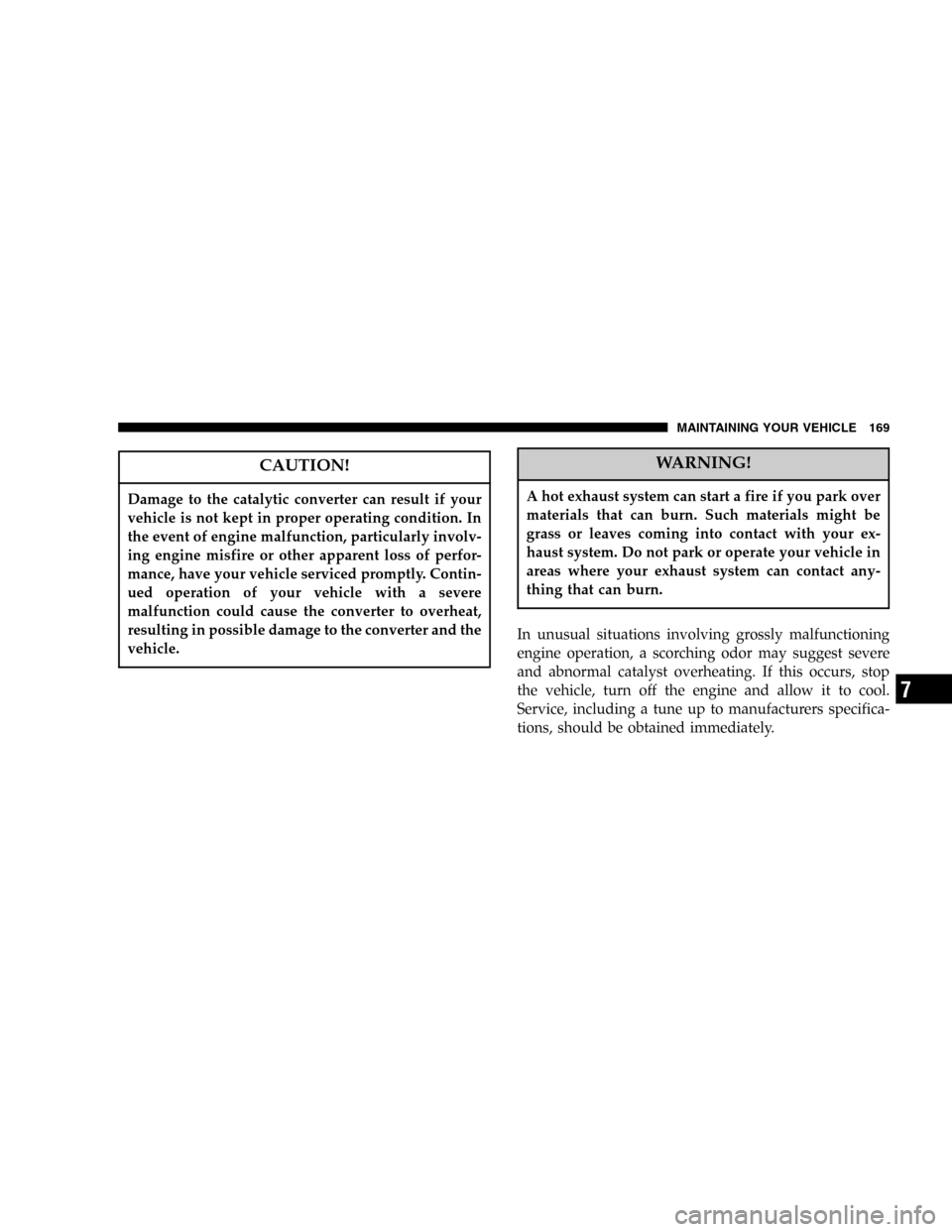2005 DODGE VIPER heating
[x] Cancel search: heatingPage 51 of 264

SAFETY TIPS
Exhaust Gas
WARNING!
Exhaust gases can injure or kill. They contain carbon
monoxide (CO) which is colorless and odorless.
Breathing it can make you unconscious and can
eventually poison you. To avoid breathing (CO)
follow the safety tips below.
•Do not run the engine in a closed garage or in confined
areas any longer than needed to move your vehicle in
or out of the area.
•If it is necessary to sit in a parked vehicle with the
engine running, adjust your heating or cooling con-
trols to force outside air into the vehicle. Set the blower
at high speed.
Safety Checks You Should Make Inside the
Vehicle
Seat Belts
•
Inspect the belt system periodically, checking for cuts,
frays and loose parts. Damaged parts must be replaced
immediately. Do not disassemble or modify the sys-
tem.
•Seat belt assemblies must be replaced after an accident
if they have been damaged (bent retractor, torn web-
bing, etc.). If there is any question regarding belt or
retractor condition, replace the belt.
Defrosters
Check operation by selecting the defrost mode and place
the blower control on high speed. You should be able to
feel the air directed against the windshield.
THINGS TO KNOW BEFORE STARTING YOUR VEHICLE 51
2
Page 90 of 264

Trunk Ajar Light
This light indicates that the trunk is not latched.
Engine Coolant Temperature Light
A red LED light on the Coolant Temperature
gauge will illuminate to warn of an overheated
engine coolant condition.
Low Oil Pressure Light
A red LED light on the Oil Pressure gauge will
illuminate to indicate low engine oil pressure. The
light should come on briefly as a bulb check when the
engine is first started. If the light stays on or comes on
while driving, stop the vehicle and shut off the engine.
DO NOT operate the vehicle until the cause is corrected.
NOTE:This light does not indicate how much oil is in
the engine. The engine oil level must be checked under
the hood.
Charge System Light
A red LED light on the Voltage gauge will illumi-
nate when there is a charging system malfunction
or a possible accessory drive belt failure.
CAUTION!
The accessory belt also drives the water pump.
Operating the vehicle with a failed belt can cause
engine overheating and possible severe engine dam-
age.
Fog Light ON Indicator
This light indicates that the fog lights are on.
90 UNDERSTANDING YOUR INSTRUMENT PANEL
Page 148 of 264

HAZARD WARNING FLASHER
The flasher switch is on the top of the steering
column, just behind the steering wheel. Depress
the flasher button and all front and rear directional
signals will flash. Depress the flasher button again to turn
the flashers off.Do not use this emergency warning system when the
vehicle is in motion. Use it when your vehicle is disabled
and is creating a safety hazard for other motorists.
If it is necessary to leave the vehicle to go for service, the
flasher system will continue to operate with the ignition
key removed.
NOTE:With extended use, the flasher may run down
your battery.
IF YOUR ENGINE OVERHEATS
In any of the following situations, you can reduce the
potential for overheating by taking the appropriate ac-
tion.
•On the highways—Slow down and use the highest
gear possible.
•In city traffic—While stopped, put the transmission
in neutral, but do not increase engine idle speed.
Hazard Flasher Switch
148 WHAT TO DO IN EMERGENCIES
Page 155 of 264

FREEING A STUCK VEHICLE
If your vehicle becomes stuck in mud, sand or snow, it
can often be moved by a rocking motion. Turn your
steering wheel right and left to clear the area around the
front wheels. Then shift back and forth between Reverse
and First gear. Usually the least accelerator pedal pres-
sure to maintain the rocking motion without spinning the
wheels is most effective.
CAUTION!
Racing the engine or spinning the wheels too fast
may lead to transmission/axle overheating and fail-
ure. It can also damage the tires. Do not spin the
wheels above 30 mph (48 km/h).
TOWING A DISABLED VEHICLE
Do not tow with sling type equipment. Only use flat bed
equipment. Always comply with applicable state or local
towing ordinances.
CAUTION!
Towing with equipment other than flat bed types
may damage your vehicle.
WHAT TO DO IN EMERGENCIES 155
6
Page 169 of 264

CAUTION!
Damage to the catalytic converter can result if your
vehicle is not kept in proper operating condition. In
the event of engine malfunction, particularly involv-
ing engine misfire or other apparent loss of perfor-
mance, have your vehicle serviced promptly. Contin-
ued operation of your vehicle with a severe
malfunction could cause the converter to overheat,
resulting in possible damage to the converter and the
vehicle.
WARNING!
A hot exhaust system can start a fire if you park over
materials that can burn. Such materials might be
grass or leaves coming into contact with your ex-
haust system. Do not park or operate your vehicle in
areas where your exhaust system can contact any-
thing that can burn.
In unusual situations involving grossly malfunctioning
engine operation, a scorching odor may suggest severe
and abnormal catalyst overheating. If this occurs, stop
the vehicle, turn off the engine and allow it to cool.
Service, including a tune up to manufacturers specifica-
tions, should be obtained immediately.
MAINTAINING YOUR VEHICLE 169
7
Page 183 of 264

Cooling System
Inspection
WARNING!
You or others can be badly burned by hot coolant or
steam from your radiator. If you see or hear steam
coming from under the hood, don’t open the hood
until the radiator has had time to cool. Never try to
open a cooling system pressure cap when the radia-
tor is hot.
Coolant Checks
Check engine coolant (antifreeze) protection every 12
months (before the onset of freezing weather, where
applicable). If coolant is dirty or rusty in appearance, the
system should be drained, flushed and refilled with fresh
coolant. Check the front of the radiator for any accumu-
lation of bugs, leaves, etc.
Check the coolant bottle tubing for condition and tight-
ness of connection at reserve tank and radiator. Inspect
the entire system for leaks.
NOTE:Check the front of the radiator for debris (leaves,
paper, etc.) regularly. A build up of such material could
lead to engine overheating.
Do not remove the cooling system pressure cap when the
cooling system is hot.
MAINTAINING YOUR VEHICLE 183
7
Page 247 of 264

Defroster, Windshield...................... 51
Delay (Intermittent) Wipers................. 82
Diagnostic System, Onboard................ 161
Dimmer Control......................... 74
Dimmer Switch, Headlight.................. 78
Disposal
Antifreeze (Engine Coolant)............... 186
Door Locks............................. 13
Door Locks, Automatic.................... 15
Doors................................. 13
Drive Belts............................ 168
Driving
On Slippery Surfaces.................... 154
Electric Remote Mirrors.................... 68
Emergency Brake........................ 116
Emergency, In Case of
Freeing Vehicle When Stuck............... 155
Hazard Warning Flasher................. 148Jump Starting......................... 150
Overheating.......................... 148
Towing............................. 155
Emission Control System Maintenance......162,218
Engine............................... 160
Break-In Recommendations................ 50
Checking Oil Level..................... 164
Compartment......................... 160
Coolant (Antifreeze).................183,213
Cooling...........................90,183
Exhaust Gas Caution..................51,145
Fails to Start.......................... 112
Fuel Requirements..................142,212
Oil ...........................164,212,213
Oil Change Interval.................... 165
Oil Disposal.......................... 167
Oil Filter............................ 167
Oil Selection.......................166,212
Overheating........................90,148
INDEX 247
10
Page 252 of 264

Outside.............................. 68
Rearview............................. 67
Modifications/Alterations, Vehicle............. 7
Mopar Parts.........................163,239
Multi-Function Control Lever................ 74
New Vehicle Break-In Period................ 50
Occupant Restraints....................... 26
Oil, Engine.......................164,212,213
Capacity............................ 212
Change Interval....................... 165
Checking............................ 164
Disposal............................ 167
Filter............................167,213
Materials Added to..................... 167
Pressure Gauge........................ 92
Recommendation...................166,212
Viscosity............................ 212Oil Filter, Selection....................... 167
Onboard Diagnostic System..............161,162
Operator Manuals (Owner’s Manuals)........... 4
Overheating, Engine...................... 148
Owner’s Manual.......................4,240
Paint Care............................. 195
Panic Alarm............................ 17
Parking Brake.......................... 116
Parking On Hill......................... 117
Passing Light........................... 78
PCV Valve............................ 171
Pedals, Adjustable........................ 79
Pets.................................. 50
Pets, Transporting........................ 50
Placard, Tire and Loading Information......... 127
Power
Accessory Delay......................13,26
Brakes.............................. 117
252 INDEX